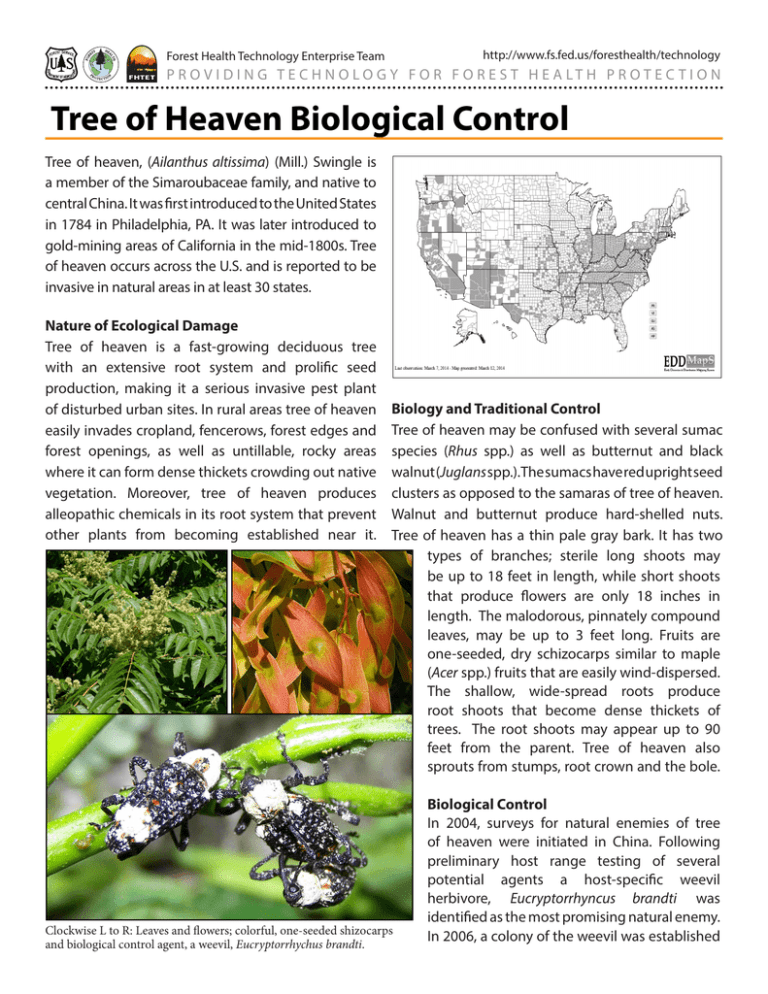Tree of Heaven Biological Control
advertisement

http://www.fs.fed.us/foresthealth/technology Forest Health Technology Enterprise Team P R O V I D I N G T E C H N O L O G Y F O R F O R E S T H E A LT H P R O T E C T I O N Tree of Heaven Biological Control Tree of heaven, (Ailanthus altissima) (Mill.) Swingle is a member of the Simaroubaceae family, and native to central China. It was first introduced to the United States in 1784 in Philadelphia, PA. It was later introduced to gold-mining areas of California in the mid-1800s. Tree of heaven occurs across the U.S. and is reported to be invasive in natural areas in at least 30 states. Nature of Ecological Damage Tree of heaven is a fast-growing deciduous tree with an extensive root system and prolific seed production, making it a serious invasive pest plant of disturbed urban sites. In rural areas tree of heaven easily invades cropland, fencerows, forest edges and forest openings, as well as untillable, rocky areas where it can form dense thickets crowding out native vegetation. Moreover, tree of heaven produces alleopathic chemicals in its root system that prevent other plants from becoming established near it. Biology and Traditional Control Tree of heaven may be confused with several sumac species (Rhus spp.) as well as butternut and black walnut (Juglans spp.).The sumacs have red upright seed clusters as opposed to the samaras of tree of heaven. Walnut and butternut produce hard-shelled nuts. Tree of heaven has a thin pale gray bark. It has two types of branches; sterile long shoots may be up to 18 feet in length, while short shoots that produce flowers are only 18 inches in length. The malodorous, pinnately compound leaves, may be up to 3 feet long. Fruits are one-seeded, dry schizocarps similar to maple (Acer spp.) fruits that are easily wind-dispersed. The shallow, wide-spread roots produce root shoots that become dense thickets of trees. The root shoots may appear up to 90 feet from the parent. Tree of heaven also sprouts from stumps, root crown and the bole. Clockwise L to R: Leaves and flowers; colorful, one-seeded shizocarps and biological control agent, a weevil, Eucryptorrhychus brandti. Biological Control In 2004, surveys for natural enemies of tree of heaven were initiated in China. Following preliminary host range testing of several potential agents a host-specific weevil herbivore, Eucryptorrhyncus brandti was identified as the most promising natural enemy. In 2006, a colony of the weevil was established Forest Health Technology Enterprise Team http://www.fs.fed.us/foresthealth/technology P R O V I D I N G T E C H N O L O G Y F O R F O R E S T H E A LT H P R O T E C T I O N at the quarantine facility of Virginia Polytechnic Institute and State University in Blacksburg, VA. The procedures for rearing the weevil and additional host range testing was completed. A petition for its release in the U.S. was submitted to the Technical Advisory Group (TAG) for Biological Control of Weeds in 2011 and their recommendation was to conduct additional host range testing which is in progress. In 2002, a native vascular wilt fungus, Verticillium nonalfalfae, was observed in Pennsylvania causing significant mortality to tree of heaven. This fungus has F OR M O R E INFO RMAT I O N CON TAC T: Richard Reardon, Program Manager Biological Control & Biopesticides USDA Forest Service 180 Canfield Street Morgantown, WV 26505 Phone: 304-285-1566 Fax: 304-285-1564 E-mail: rreardon@fs.fed.us also been recovered on tree of heaven in VA and OH. The weevil E. brandti has been shown to successfully carry and transmit V. nonalfalfae to tree of heaven. Also a large percentage of surviving weevils overwintering in the soil were able to carry viable V. nonalfalfae propagules externally. Following extensive host range testing, the fungus is being distributed at various test sites within the state of Pennsylvania for establishment and developing infestation. A revised petition has been submitted to the TAG for release of the weevil.







